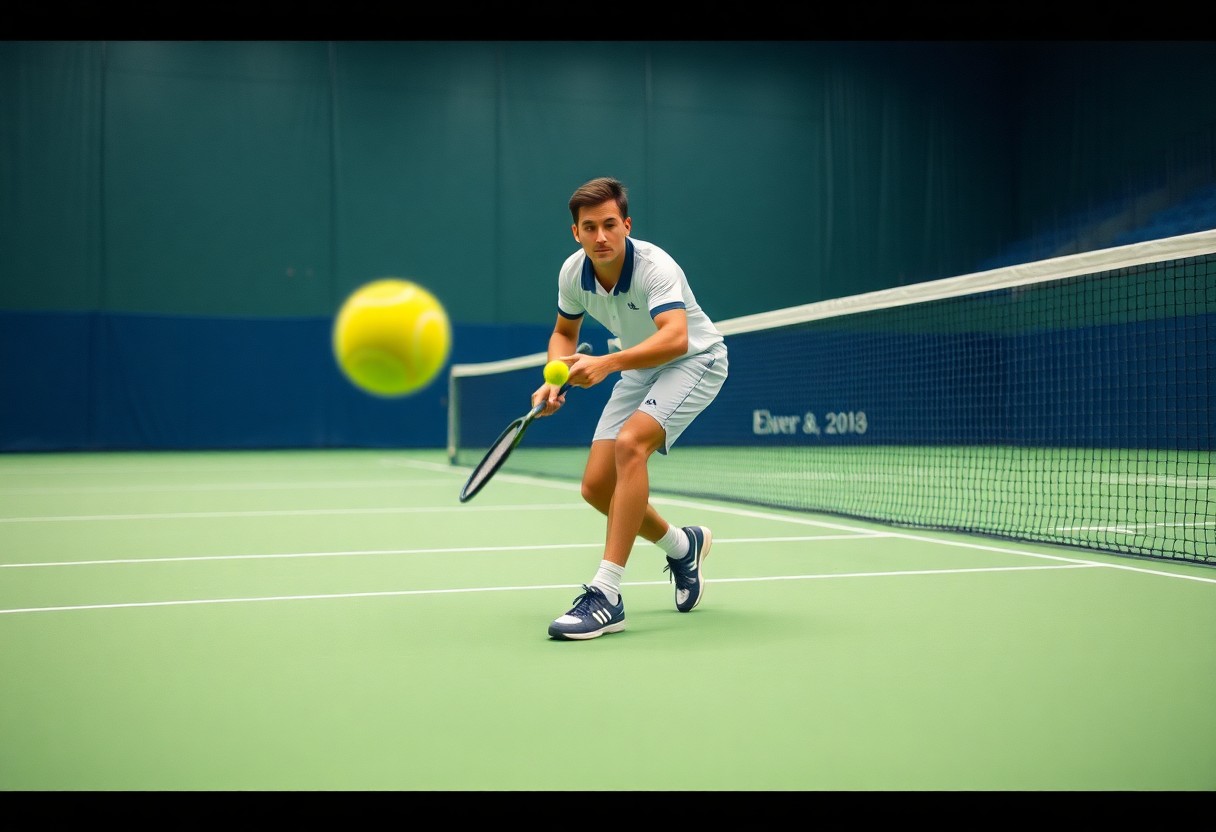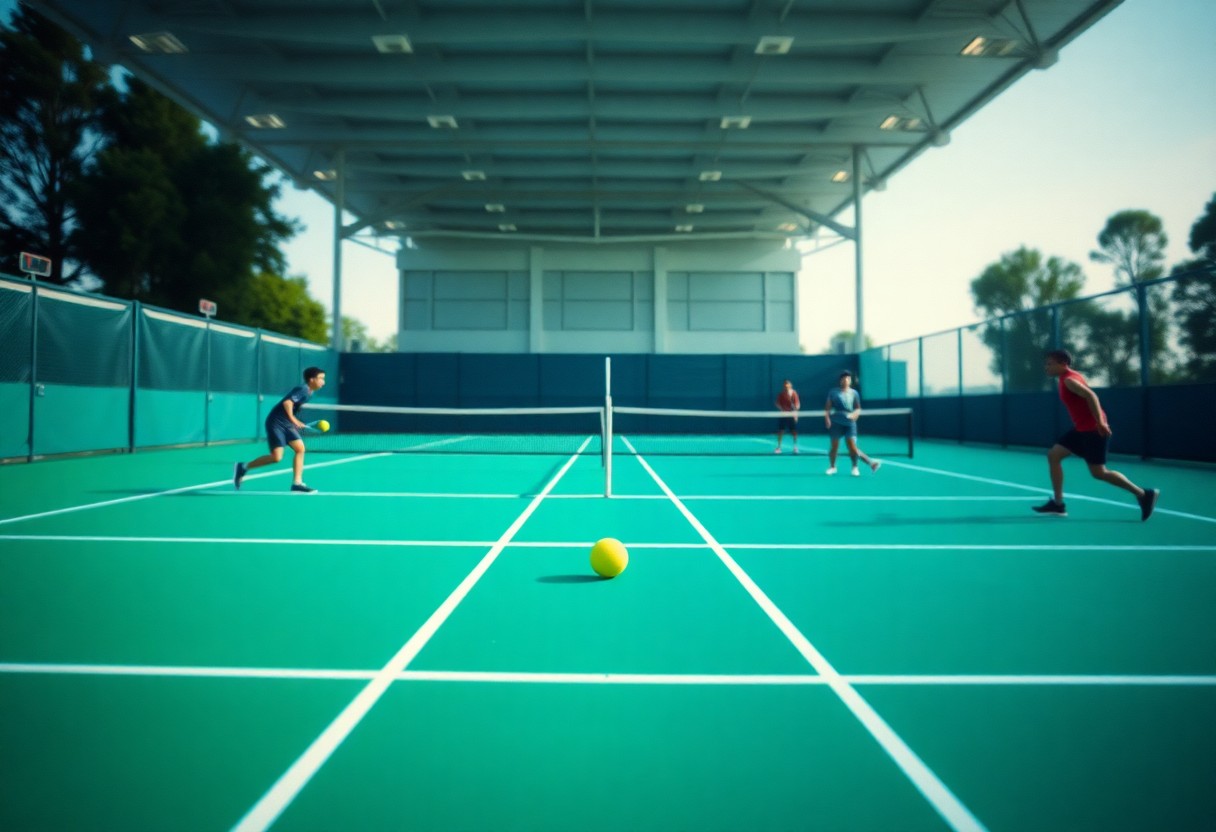Positioning on the tennis court is necessary for executing effective strategies and enhancing overall performance. By understanding the dynamics of court coverage and player placement, players can dictate rallies and capitalize on their opponent’s weaknesses. Mastering this skill provides a strategic advantage, allowing for offensive plays while minimizing vulnerabilities. This guide explores fundamental principles of court positioning, ensuring players can elevate their game and make informed decisions during matches.
Understanding Court Positioning
Mastering court positioning is important for dictating the pace and flow of a match. A player’s ability to place themselves strategically can enhance their defense and improve opportunities for offense. Correct positioning enables players to anticipate opponents’ moves, react effectively, and capitalize on weaknesses, establishing control over rallies.
Types of Court Positions
There are several primary types of court positions that players can adopt based on their game style and strategy. These positions influence how a player interacts with the ball and their opponent.
| Position | Description |
| Baseline | Players stand near the back line to maximize reaction time. |
| Mid-Court | Players position themselves halfway between the baseline and the net. |
| Net | Players approach the net to execute volleys and capitalize on short balls. |
| Defensive | Players retreat behind the baseline to defend against powerful shots. |
| Aggressive | Players move forward to control points and pressure their opponent. |
Key Factors Influencing Positioning
Several critical factors influence a player’s positioning during rallies. These factors include opponent’s positioning, shot selection, and game conditions, all of which demand quick adjustments in placement.
- Opponent’s movement affects how a player positions themselves.
- Ball trajectory determines the ideal spot for effective returns.
- Game tempo influences a player’s readiness and reaction.
- Court surface changes affect speed and bounce.
- Player style plays a role in positioning decisions.
Recognizing these key factors allows players to adapt their strategy dynamically, enhancing their overall performance and effectiveness on the court.
Adapting to these factors involves constant observation and awareness; for instance, when an opponent is excessively aggressive or consistently hitting deep, adjusting positioning can significantly shift the momentum. A player’s responsiveness to these nuances can mean the difference between winning and losing points. Strategically modifying your position based on elements such as opponent’s tendencies and court conditions lays a solid foundation for executing effective plays.
- Awareness of opponent’s shot choices is important.
- Footwork enhances a player’s ability to position quickly.
- Spatial awareness allows for broader tactical opportunities.
- Game analysis aids in foreseeing potential plays.
- Match tempo influences how aggressively to position.
Recognizing these factors ensures a player can capitalize on their advantages and mitigate potential threats effectively.
Tips for Effective Court Positioning
Effective court positioning can significantly enhance your game. To optimize your stance, consider the following strategies:
- Maintain a low center of gravity to stay balanced.
- Position yourself towards the middle of the court for better coverage.
- Move quickly to adjust your position after each shot.
- Anticipate your opponent’s shot placement.
- Utilize a split-step before your opponent strikes the ball.
After mastering these tips, you’ll find yourself in a prime position to respond to various scenarios on the court.
Anticipation and Reaction Time
Anticipation and reaction time play a vital role in effective court positioning. By reading your opponent’s body language and racket angles, you can predict their next move and position yourself accordingly. Forming a mental map of your opponent’s playstyle allows you to react quicker, decreasing the time it takes to reach the ball and improving your chances of making a successful return.
Adjusting Position Based on Opponent’s Play
Adapting your position based on an opponent’s play is key to staying competitive. If they tend to hit deep, position yourself farther back; if they favor the net, move closer. Understanding their shot patterns is crucial. For instance, if you notice your opponent repeatedly placing balls to your forehand, shifting your stance slightly to favor that side can improve your response time and shot quality. Recognizing these trends allows for more strategic positioning throughout the match.
Step-by-Step Guide to Master Court Positioning
| Step | Description |
|---|---|
| 1 | Assess your opponent’s strengths and weaknesses to anticipate their shots. |
| 2 | Establish a solid stance that allows for quick lateral movement. |
| 3 | Position yourself behind the baseline during rallies for better depth. |
| 4 | Move forward to cut angles when your opponent is caught off-balance. |
| 5 | Adapt your positioning when approaching the net for volleys based on the ball’s trajectory. |
Drills to Improve Positioning Skills
Incorporating specific drills into your training will enhance your court positioning. Drill with a partner, focusing on maintaining proper stance while reacting to randomly hit balls. Utilize cone drills to practice lateral movement and quick footwork, ensuring that you can adjust your position swiftly during points. Shadow swings can further reinforce muscle memory in various court areas, enabling more fluid adjustments during matches.
Strategies for Various Match Scenarios
Adopting effective strategies based on match scenarios is vital for optimizing your court positioning. Understand how to shift your stance when playing against a powerful server versus a baseline player. For aggressive players, stay a step back to allow time for powerful returns; against defensive players, you may need to move closer to apply pressure and dictate play with deep shots. Positioning should also adapt based on whether you’re leading or trailing in games, influencing your overall strategy and confidence.
For instance, leading players can afford to be slightly aggressive, encroaching on the opponent’s territory, while those trailing may need to adopt a more conservative approach, keeping their positioning stable to avoid unnecessary risks. It’s vital to calculate the risk-reward factor based on your opponent’s abilities and current match dynamics. Video analysis can help you visualize how best to adjust your positioning according to these scenarios, leading to smarter, more effective play on the court.
Pros and Cons of Different Positioning Strategies
| Pros | Cons |
|---|---|
| Maximized court coverage | Higher risk of being caught out of position |
| Opportunities for aggressive shots | Increased likelihood of unforced errors |
| Enhanced ability to dictate play | Requires exceptional fitness and stamina |
| Pressure on opponents | Can lead to defensive lapses if overcommitted |
| Effective against weaker opponents | May backfire against strong baseline players |
| Fosters confidence in shot-making | Possibility of quick point losses |
| Promotes aggressive mindset | Can lead to frustration if strategy fails |
| Facilitates quick changes during play | Potential for poor decision-making under pressure |
| Provides strategic variety | Requires sharp awareness and court sense |
Aggressive vs. Defensive Positioning
Aggressive positioning aims to control the point by taking balls early and pushing opponents back, creating opportunities to win points faster. In contrast, defensive positioning prioritizes safety and court coverage, allowing players time to react and strategize. The choice depends on individual playing style, match context, and the opponent’s strengths and weaknesses.
Impact on Player’s Performance
The impact of court positioning on a player’s performance is profound. Players utilizing aggressive positioning often experience increased confidence and shot variety, while defensive positioning can enhance consistency and error reduction. This dual approach allows adaptability during matches, as players learn to switch strategies based on their opponent’s tactics, thus influencing match dynamics significantly.
Common Mistakes in Court Positioning
Analyzing common pitfalls in court positioning can greatly improve your game. One prevalent error is overcommitting to the net, which can leave players vulnerable to passing shots. Additionally, neglecting defensive readiness can significantly compromise your ability to respond effectively during rallies. These mistakes not only disrupt flow but can also lead to unnecessary points lost against opponents who capitalize on both missteps.
Overcommitting to the Net
Overcommitting to the net is a frequent error that destabilizes positioning. Tennis players often rush forward to cut off angles or intercept shots, but this can backfire, leaving them susceptible to lob shots or well-placed passes. By remaining overly aggressive, players might find themselves stranded mid-court, forcing awkward recovery movements and missed opportunities.
Neglecting Defensive Readiness
Failing to maintain defensive readiness can severely diminish a player’s competitiveness. If you position yourself too far inside the court, you risk being caught off guard by powerful baseline shots. Defensive readiness ensures you’re always prepared to react, enhancing your chances of returning a difficult ball. Staying balanced and grounded, while keeping your weight slightly back, allows for optimal movement and responsiveness, significantly improving your game strategy.
In matches, a player lacking defensive readiness may find themselves consistently scrambling to retrieve balls, leading to fatigue and errors. For instance, when facing a strong, deep shot, if you have not maintained a balanced stance, your recovery becomes compromised. Staying light on your feet and anticipating potential shots enables you to adjust quickly and effectively. This readiness not only prepares you for incoming attacks but also allows for smoother transitions between offensive and defensive play, giving you a strategic edge on the court.
Adapting Court Positioning for Different Playing Styles
Understanding your opponent’s playing style is paramount for effective court positioning. For aggressive baseliners, maintaining a deeper position can help you absorb power and counterattack, while net rushers require you to take the initiative, moving forward to challenge their approach shots and cut down angles. By analyzing these styles, you can position yourself to exploit weaknesses and enhance your overall strategy.
Singles vs. Doubles Positioning
The dynamics of singles and doubles tennis necessitate different court positioning strategies. In singles, players rely on personal court coverage, often positioning themselves deeper to anticipate shots. In contrast, doubles involves strategic formations, with players needing to communicate and position closer to the net, enabling rapid exchanges and volleying opportunities.
Adjusting for Different Court Surfaces
Court surfaces significantly impact movement and shot dynamics, requiring players to adjust their positioning accordingly. On grass, for instance, the ball tends to skid, making quick reactions imperative, while clay courts slow down play, allowing for deeper positioning and longer rallies.
Each court surface demands unique adjustments in your approach. On hard courts, you can afford a balanced mix of aggressive and defensive positioning due to consistent bounce. In clay, positioning deeper is often advantageous, as slower ball speed grants more time to react. Conversely, on grass, adopting a forward stance helps capitalize on quick points and net play, enhancing volley opportunities. A savvy player adapts their footwork and reaction time based on these surface characteristics to maintain a competitive edge.
Summing up
Conclusively, mastering court positioning is vital for developing effective tennis strategies, as it directly influences shot selection, pace control, and defensive capabilities. By understanding the spatial dynamics between players and recognizing the importance of placing oneself advantageously on the court, players can dictate the flow of the game. Strategic positioning not only enhances individual performance but also facilitates opportunities for exploiting opponents’ weaknesses, thereby elevating the overall competitive edge. Prioritizing this foundational aspect of tennis will lead to improved outcomes on the court.
FAQ
Q: What is court positioning in tennis?
A: Court positioning refers to the placement of a player’s feet and body in relation to the ball and their opponent. Effective court positioning allows players to anticipate shots, react quickly, and maintain control of the rally by being in the best place to hit the ball optimally.
Q: How can mastering court positioning improve my game?
A: Mastering court positioning enhances your ability to play offensive and defensive shots. It enables you to cut off angles, return serves effectively, and create opportunities for winning points. By being well-positioned, players can conserve energy, reduce the risk of injuries, and increase the chances of consistent performance.
Q: What are some drills to practice court positioning?
A: Effective drills include shadowing your strokes while focusing on footwork, practicing lateral movement drills, and engaging in live-ball situations where you adjust your position according to your opponent’s shots. Incorporating these drills into your training can significantly enhance your awareness and execution of optimal court positioning during matches.




